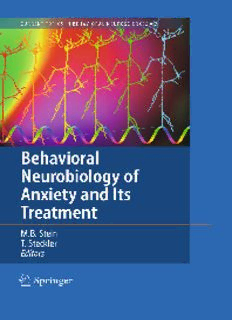
Behavioral Neurobiology of Anxiety and Its Treatment PDF
Preview Behavioral Neurobiology of Anxiety and Its Treatment
Current Topics in Behavioral Neurosciences Series Editors: Mark Geyer, La Jolla, CA, USA Bart Ellenbroek, Hamburg, Germany Charles Marsden, Nottingham, UK Aboutthisseries Current Topics in Behavioral Neurosciences provides critical and comprehensive discussions of the most significant areas of behavioral neuroscience research, written by leading international authorities. Each volume offers an informative andcontemporaryaccountofitssubject,makingitanunrivalledreferencesource. Titlesinthisseriesareavailableinbothprintandelectronicformats. With the development of new methodologies for brain imaging, genetic and genomicanalyses,molecularengineeringofmutantanimals,novelroutesfordrug delivery,andsophisticatedcross-speciesbehavioralassessments,itisnowpossible tostudybehaviorrelevanttopsychiatricandneurologicaldiseasesanddisorderson the physiological level.The Behavioral Neurosciences series focuses on ‘‘transla- tional medicine’’ and cutting-edge technologies. Preclinical and clinical trials for thedevelopment ofnewdiagnosticsandtherapeuticsaswellasprevention efforts arecoveredwheneverpossible. . Murray B. Stein Thomas Steckler l Editors Behavioral Neurobiology of Anxiety and Its Treatment Editors Dr.MurrayB.Stein Dr.ThomasSteckler DepartmentsofPsychiatryand Johnson&JohnsonPharmaceuticals Family&PreventiveMedicine Research&Development UniversityofCaliforniaSanDiego CNSDrugDiscovery 9500GilmanDrive(0855) 2340Beerse LaJolla,CA92093-0855 Belgium [email protected] [email protected] ISSN1866-3370 e-ISSN1866-3389 ISBN978-3-642-02911-0 e-ISBN978-3-642-02912-7 DOI10.1007/978-3-642-02912-7 SpringerHeidelbergDordrechtLondonNewYork LibraryofCongressControlNumber:2010929746 #Springer-VerlagBerlinHeidelberg2010 Thisworkissubjecttocopyright.Allrightsarereserved,whetherthewholeorpartofthematerialis concerned,specificallytherightsoftranslation,reprinting,reuseofillustrations,recitation,broadcasting, reproductiononmicrofilmorinanyotherway,andstorageindatabanks.Duplicationofthispublication orpartsthereofispermittedonlyundertheprovisionsoftheGermanCopyrightLawofSeptember9, 1965,initscurrentversion,andpermissionforusemustalwaysbeobtainedfromSpringer.Violationsare liabletoprosecutionundertheGermanCopyrightLaw. Theuseofgeneraldescriptivenames,registerednames,trademarks,etc.inthispublicationdoesnotimply, evenintheabsenceofaspecificstatement,thatsuchnamesareexemptfromtherelevantprotectivelaws andregulationsandthereforefreeforgeneraluse. Product liability: The publishers cannot guarantee the accuracy of any information about dosage and applicationcontained in thisbook.In everyindividualcasethe usermust checksuchinformationby consultingtherelevantliterature. Coverillustration:Artisticrepresentationofoscillatorysynchronyandtimingofneuronsinnetworksby GyorgyBuzsaki Coverdesign:WMXDesignGmbH,Heidelberg,Germany Printedonacid-freepaper SpringerispartofSpringerScience+BusinessMedia(www.springer.com) Preface ThebookispartofaseriesonCurrentTopicsinBehavioralNeurosciences,which hasasitsfocusanxietyanditstreatment.Wehavebroughttogetheradistinguished cadreofauthorswiththeaimofcoveringabroadarrayoftopicsrelatedtoanxiety disorders,rangingfromclinicaldiagnosis,epidemiology,preclinicalneuroscience, andanimalmodelstoestablishedandinnovativetherapeuticapproaches.Thebook aims at bridging these disciplines to provide an update of literature relevant to understandinganxiety,itsconsequences,anditsmanagement.Followingisabrief overviewofthechaptersandtheircontent,meanttoserveasaguidetonavigating thebook. Thefirst sectioncoversclinical aspects ofanxiety disorders. Joe Bienvenuand colleaguesprovideanincisiveoverviewofdiagnosticconsiderationsintheanxiety disorders in which they emphasize the strengths and shortcomings of our current nosologicsystems.Thisisfollowedbyareviewandupdateoftheepidemiologyof anxiety disorders by Ron Kessler and colleagues, which provides an authoritative surveyofanxietydisorderincidence,prevalence,andriskfactors.Thisiscomple- mentedbyacomprehensivereviewoftheliteratureondisordersthatco-occurwith anxiety disorders by Kathleen Merikangas and Sonja Alsemgeest Swanson. Their review highlights the tremendous comorbidity that occurs not only within the anxietydisorders,butalsowithothermentalandphysicalhealthconditions. Thesecondsectionisdevotedtoclinicalneurosciencetopicsthataregermaneto anxietydisorders.KatharinaDomschkeandJu¨rgenDeckertprovideasummaryof genetic findings in the anxiety disorders. Newton Sabino Canteras and colleagues describe neuroanatomical structures and circuits relevant to anxiety and anxiety disorders. This section is concluded by Jose´ Miguel Peˆgo and colleagues with a criticaloverviewoftheneuroendocrinologyofanxietyandstress,tyingthistogeth- erwithfindingsinanxietyandstressdisorders. Thethirdsectionfocusesonanimalmodels.DallasTreitandcolleaguesprovide anoverviewonpreclinicaltestsofanxiety-relatedbehavioranddiscussthevalidity ofthesetestsandtheirsensitivitytopharmacologicalintervention.Thisisfollowed by a review by Laura Jacobson and John Cryan on genetic animal models of anxiety, a discussion of the strengths and weaknesses of such models, and their v vi Preface contribution to our understanding of the neurobiological and genetic basis of anxietydisorders. The fourth section is devoted to translational science that can inform our understandingofanxietydisorders.VictoriaRisbroughdiscussesbehavioralcorre- latesofanxietydisorderswithaspecial emphasisonworkthathasused emotion- (usuallyfear-)potentiatedstartletotesttheintegrityofparticularanxiety-relevant circuitsinhumans.MarliesvanDuinenandcolleaguesprovideareviewoftheso- called challenge studies in anxiety, in which subjects are exposed to substances (e.g., pharmacologicalagents)intendedto evoke anxiety asa test oftheir specific properties. Their particular emphasis in this chapter is on challenges to and responsesoftherespiratorysystemwhich,arguably,havebeenbeststudiedinthe anxiety disorders, particularlypanicdisorder.AmitEtkinsubsequentlyprovidesa comprehensive review of the functional neuroimaging literature in anxiety disor- ders.Heexaminesthesimilaritiesanddifferencesacrossanxietydisordersthathave emerged from this literature, much of it using functional magnetic resonance imaging(fMRI). Finally, ina tourde force ofthe merits oftranslational research, Dennis Choi and colleagues provide a rationale for the pharmacological enhance- mentofbehaviortherapyforanxietydisorders. The fifth section covers the preclinical pharmacology of systems that are rele- vant to anxiety, as well as some of the molecular targets for potential anxiolytics withnovelmechanismofaction.ClaireDurantandcolleaguessetthescenewitha reviewoftheclinicalneurochemistryofanxietydisorders,emphasizingthediffer- entneurochemicalsystemsthataretargetedbycurrentlyusedandnewlydeveloped anxiolytic drugs. This is followed by an authoritative overview by John Atack on GABAergic approaches, delineating the potential of GABA-A subunit-specific compoundstotreatanxietydisorders.AntonBespalovandcolleaguesthendiscuss theimportance ofantidepressantdrugs inthetreatmentof anxiety disorders, espe- ciallytheconundrumthatpreclinicalanimalmodelsoftenfailtodetectanxiolytic- likeeffectsofantidepressantsdespitetheirclinicalutility.Theirinterestingproposal istoalsoconsidercognitivecomponentsofanxiety-relatedbehaviorandtoexpand thearmamentariumofpreclinicalmodelsrelevanttoanxietytomorereadilydetect the efficacy of antidepressant drugs. Will Spooren and colleagues subsequently review the emerging field of compounds acting at the different metabotropic glutamate receptors as an innovative avenue for the development of novel anxio- lyticdrugs,followedbyasummarybyThomasSteckleronthestatusofneuropep- tidergic approaches to the treatment of anxiety disorders, especially focusing on clinicalproof-of-conceptstudieswithsmall-molecule,nonpeptidergicantagonistsof the CRF1, NK1 and 3, and CCK2 receptors, but also on the atrial natriuretic and oxytocinsystems.Thissectionconcludeswithastate-of-the-artoverviewbyFabricio Moreira and Carsten Wotjak on cannabinoids and anxiety, and modulation of the endogenouscannabinoidsystemasyetanotherpromisingtherapeuticapproachinthe questfornovel,moreefficaciousandbettertoleratedanxiolyticdrugs. The sixth and final section of the book reviews the clinical pharmacology of anxiety disorders. This section is organized such that each chapter provides an authoritative review of the literature on the pharmacological management of the Preface vii most common anxiety disorders. David Baldwin and colleagues review the phar- macotherapyofgeneralizedanxietydisorder(GAD)andthenJeffreyLightfootand colleaguesdothesameforpanicdisorder.KeithGanasenandDanSteinsummarize theevidencebasefor thepharmacotherapyofsocialphobia(alsoknownassocial anxiety disorder), highlighting areas where knowledge is strong and where it is especially sparse. Lakshmi Ravindran and Murray Stein review the evidence for pharmacologicaltreatmentofposttraumaticstressdisorder(PTSD),atopicthathas beenespeciallycontroversialandinthenewsoflate,givenrecentmilitaryconflicts aroundtheworldandtheincreasedawarenessoftheirimpactonhealthofcomba- tants and civilians alike. Blair Simpson closes this section with a summary of the pharmacotherapy of obsessive compulsive disorder (OCD), a particularly chronic anddifficult-to-treatanxietydisorderforwhichnewtreatmentsaresorelyneeded, buthavebeenslowincoming. These chapters, individually and in their aggregate, provide a broad summary andsynthesisofbehavioralneurosciencefindingsinanxietyandadetailedupdate on its treatment. As we look forward to the future – as many of the authors have done in their chapters – we are particularly excited about recent advances in the translationalneuroscienceofanxietywhichpromisetoleadtothedevelopmentof morepotenttherapiesforthepatientswhoneedthem. MurrayB.Stein ThomasSteckler LaJolla,CA,USA Beerse,Belgium . Contents PartI AnxietyDisorders-Clinical AnxietyDisordersDiagnosis:SomeHistoryandControversies ............. 3 O.JosephBienvenu,LisaA.Wuyek,andMurrayB.Stein EpidemiologyofAnxietyDisorders ............................................ 21 RonaldC.Kessler,AyeletMeronRuscio,KatherineShear, andHans-UlrichWittchen ComorbidityinAnxietyDisorders ............................................. 37 KathleenRiesMerikangasandSonjaAlsemgeestSwanson PartII AnxietyDisorders-ClinicalNeuroscience Genetics .......................................................................... 63 KatharinaDomschkeandJu¨rgenDeckert NeuroanatomyofAnxiety ...................................................... 77 NewtonSabinoCanteras,LeonardoBarbosaResstel,LeandroJose´ Bertoglio, AntoniodePa´duaCarobrez,andFranciscoSilveiraGuimara˜es StressandtheNeuroendocrinologyofAnxietyDisorders ................... 97 J.M.Peˆgo,J.C.Sousa,O.F.X.Almeida,andN.Sousa PartIII AnimalModels AnimalModelsofAnxietyandAnxiolyticDrugAction ................... 121 DallasTreit,ElifEngin,andKrisMcEown ix
Description: